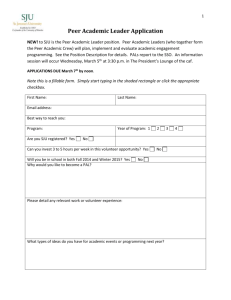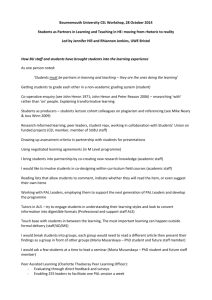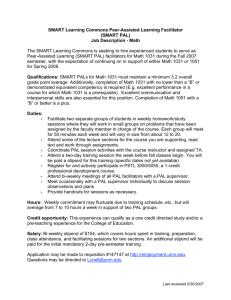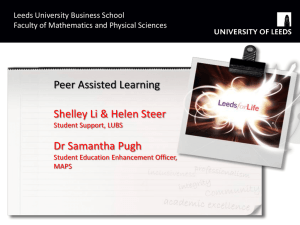Peer Assisted Learning
advertisement
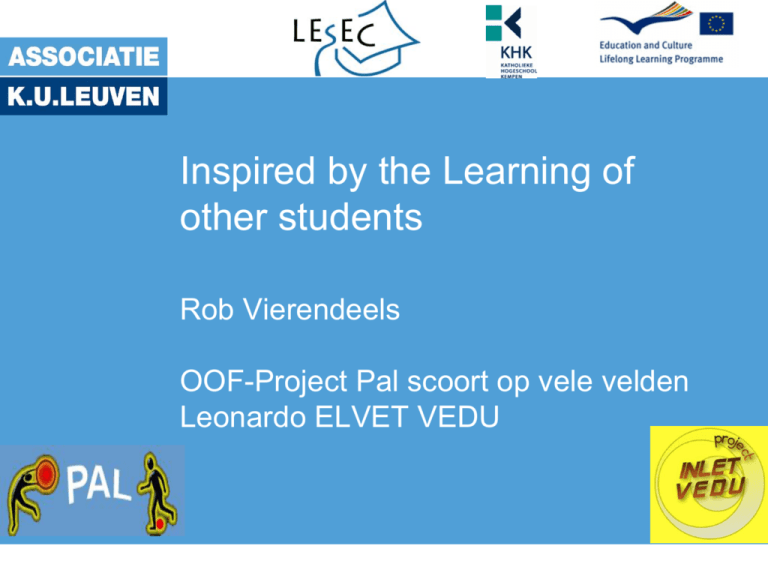
Inspired by the Learning of other students Rob Vierendeels OOF-Project Pal scoort op vele velden Leonardo ELVET VEDU PAL -classification • People (students), who are not professional teachers, help and support the learning process of others, in an interactive, purposeful and systematic way (Topping) • PAL as a coaching instrument (student & learning support) PAL -classification • Peer Assisted Learning: a definition • Peer Assisted Learning (PAL) is a scheme that fosters cross-year support between students on the same course. PAL encourages students to support each other and to learn co-operatively under the guidance of students from the year above. PAL -classification • • • • • • • Peer Assisted Learning / Peer Tutoring e-PAL / face-to-face/ BLENDED TUTOR: Compulsory/ integrated in curriculum/ volunteer/ paid TUTEE: Compulsory / advised / free Same-age / cross-age Reciprocal / fixed Matching: • • • • Tutor-tutee (fixed), tutor- group (sessions), tutor – tutee (free, demand driven) Group tutors- tutees 20 Principles of PAL (Bournemouth University) 1. It supports student learning. 2. It fosters cross-year support for students. 3. It is facilitated by more experienced students who provide a point of contact for new or less experienced students 4. It enhances students' experience of university life 5. It is participative: (in small groups, engaging in discussions and interactive learning activities) 6. It is timetabled 7. It encourages collaborative learning rather than competitive learning 8. Both what students learn and how they learn. 9. It creates a safe environment : to ask questions and receive guidance about the course and its content. 20 Principles of PAL (Bournemouth University) 10. It uses the language of the subject discipline 11. It helps students gain insight into the requirements of the course and their lecturers' expectations 12. It involves active rather than passive learning 13. It does not create dependency 14. It encourages independent learning 15. It helps students to develop a more positive attitude towards learning, keeping up with their studies and completing their course 20 Principles of PAL (Bournemouth University) 16. 17. 18. 19. 20. It gives students opportunities to improve their academic performance. What is discussed is confidential and remains within the PAL Group It benefits all students regardless of their current academic ability It gives students a place and a time to practice the subject, learn from mistakes and build up confidence It gives PAL Leaders opportunities to revisit their prior learning. Aims of PAL 5 intended outcomes for PAL PAL is intended to help students: • integrate quickly to academic life • improve their learning and study skills • enhance their understanding of the subject matter of their course through collaborative group discussion • prepare better for assessed work and examinations • gain insight into the requirements of their programme, programme direction and their lecturers’ expectations from the perspective of a more experienced student from the year Pal types (Fleming) Explain, advice Think logical PAL •Research shows tutoring can be highly effective… • To teach is to learn twice… • Learning to work in a team PAL effective? Compared to professional teaching, it can give: • more practice; • more activity and variety; • more individualized help; • more questioning; • simpler vocabulary; • more local relevant examples; PAL effective? Compared to professional teaching, (2): • higher disclosure of misunderstanding; • more prompting and self-correction; • more immediate feedback and praise; • more opportunities for generalization; • more insight into learning (metacognition); and • more self-regulation PAL effective? Compared to professional teaching (3): •While a tutor can offer a greater quantity of individual support, the quality of that support can be poorer •The detection of errors and misconceptions by tutors might be less reliable •Tutors might tell their tutees something which is actually incorrect, reinforce mistakes or misconceptions •Tutors might become impatient and just tell their tutee the right answer, or do the task for them, in which case the tutee will learn very little. PAL: introducing Recruit and match learning tutor and tutee with care: •to receive course credit or payment for tutoring? •voluntary tutors might be assumed to be better motivated? •Tutoring by very able tutors in the subject is more beneficial to the tutee – Motivation Tutor? •Students often prefer less able students (Peter Caris) •smaller difference in ability seems to be much more challenging and engaging for the tutors •in the project “PAL scores on many fields, we recognise the self-selection: students only want to become tutor in a discipline in witch they feel themselves strong. •the best way seems to have an informal talk with students you think they are able: intelligence, social skills. PAL: introducing Recruit and match learning tutor and tutee with care: • Schedule contact time – – – – How often will the pair meet each week? Where? How long will each session be? Over how many weeks? Both tutor and tutee must be clear about their time commitment. Global estimation of number of tutors you need • Handling absence – – Consider how to deal with the absence of tutor or tutee. You might wish to name a ‘standby’ tutor as back-up. PAL: introducing •Specify tutoring method, provide training and access to materials • Consider general or specific tutoring skills – Or some of both? – Structured by specific materials, or not? • Training of tutors • Access to materials PAL: introducing •Monitor, give feedback and intervene to maximize effectiveness • • • • • Goals of monitoring Self-help guide Self-referral - coach Self-recording (log book) Direct observation Tutor formation Small group discussions with focus on: • What PAL is all about • How to run planned, structured and purposeful PAL sessions • Activities and techniques PAL Leaders can use to encourage small group interaction in their PAL sessions • Practising the above in simulated sessions • Meeting with experienced leaders from previous years • Issues relating to the boundaries of their role • Planning time for their first PAL session • Assertiveness / working with international students • Didactical setting (theory) Tutor formation • Redirecting questions • Students will expect the tutor to provide answers to their questions. It is appropriate for the tutor to answer when students want to know about the university or the locality. • PAL sessions should be about sharing and discussion of ideas, and improving students' understanding. • People learn best through practicing, testing out their ideas, getting feedback from others, and reflecting on their experiences. In other words when they make the effort to be active in their learning, take responsibility for their own learning and relate and apply new information to their own or a new context. • So students should be discouraged from taking the easy option of asking the tutor to tell them the answers to all their questions. Redirected questions means the group has to answer. Tutor formation • Redirecting questions Some useful, general redirection questions: • "Can anyone help X answer that question?" • “What was said in the lecture about this? • “Where do you find this in the course material?” • “What information would you need to be able to answer that?” • “Does anyone have any hints about this is their notes?” • “What is the first thing you would need to do …? What do you need to do next …?” • "What is it?" (i.e. definition) • "What is its purpose?" • "When would you use it?" Tutor formation • What PAL is all about • How to run planned, structured and purposeful PAL sessions • Activities and techniques PAL Leaders can use to encourage small group interaction in their PAL sessions • Practising the above in simulated sessions • Meeting with experienced leaders from previous years • Issues relating to the boundaries of their role • Planning time for their first PAL session • Assertiveness / working with international students • Working with e-Pal • Didactical setting (theory) Boundary setting activity Some typical questions we as PAL Leaders were asked: • • • • • • Is PAL compulsory? Can we look at the assignments you did last year? Can you check our assignment for quality? These “assessment criteria”, what is that all about? Can you explain this lecturer’s handout to me? Do you fancy having a drink with me? E-Pal (M. De Smed) Concepts: • e-tutoring, • online mentoring, • e-coaching, • e-moderating The specific structure of the Salmon model is helpful in training student tutors in discussion groups. E- PAL Salmon (2000) E-Pal (M. De Smed) 1 • • • ‘access and motivation’ Welcoming Offering technical support to get online. Online e-moderators pay attention to the participants’ readiness to learn in a digital environment. When participants feel comfortable with the medium, they start submitting contributions. • Getting to know each other, sharing empathy, • Having a clear sense of the ‘discussion group E-Pal 2 audience’ is the priority 1 in‘online socialisation’. • e-moderators help establishing a feeling of ‘community’ • guarantees that everyone feels respected and heeds respect for the input of others • A pleasant and constructive atmosphere is fundamental for further learning E-Pal 3 ‘information exchange’, • learning is the prominent objective • The role of the e-moderator is giving direction by submitting plenty of messages. • help to focus on the task or problem • shed light on the most relevant topics • provide supportive content-related information. E-Pal 4 ‘knowledge construction’ • social negotiation and task-related engagement • knowledge construction: explore issues, take positions, discuss their positions in an argumentative format, and reflect on and re-evaluate their positions. • e-moderators: a facilitator, not a transmission role. • They ask questions, reformulate input, keep an eye on the structure of the debate, and summarise what has been stated thus far. • Purpose is sharing meaning and building common understanding. E-Pal 5.‘development’, •Participants reassess their own thinking and explore the social learning processes. •Key ingredient :reflection and being responsible for one’s own learning. •e-moderators: challenge learners’ thoughts, for example by playing the devils’ advocate and by encouraging critical thinking. •The more participants rethink and reconsider their contributions, the more stage five has been reached. E-Pal 5.‘development’, •Participants reassess their own thinking and explore the social learning processes. •Key ingredient :reflection and being responsible for one’s own learning. •e-moderators: challenge learners’ thoughts, for example by playing the devils’ advocate and by encouraging critical thinking. •The more participants rethink and reconsider their contributions, the more stage five has been reached. Examples • Information exchange • Modelling and illustrating the contents with • examples, personal views, and concepts • The theory of PDP describes the following idea . . . • Bringing in other content information • You can draw inspiration from the media mentioned in the course book and on the Internet. • I would like to advise this website • Explaining the learning task 4 Knowledge construction • Asking for content explanations and clarification: Can you give an example? So, the point is that . . ., can you rephrase . . . •Asking to summarise: It would be nice that someone makes a scheme of the arguments. •Giving feedback about learning and social processes, giving suggestions During this discussion theme you all have done the best to motivate each other, to cooperate, to answer my questions, to add extra information, and to present experiences. PAL: Literature Annis, L.F. (1983). 'The processes and effects of peer tutoring', Human Learning, 2(1), 39-47. Benware, C.A. & Deci, E.L. (1984). 'Quality of learning with an active versus passive motivational set', American Educational Research Journal, 21(4), 755-765, Bevers A., Verschueren N., Verfaillie K., (2007), ‘Studentassistentie als middel tot probleemgestuurd onderwijs in een integratieve setting binnen de bachelor psychologie’, Intern rapport, Faculteit psychologie en pedagogische wetenschappen, KULeuven Bossaerts, B. (2007), Student tutoring. Good practices in België, Koning Boudewijnstichting. Committee on Undergraduate Science Education, Ch4, (1997), Misconceptions as Barriers to Understanding Science, http://www.nap.edu/readingroom/books/str/4.html De Boeck, P. (2003). Student-assistentie bij probleemgestuurd onderwijs in werkcolleges en practicumvakken van de tweede kandidatuur psychologie. Eindrapport OOI project (vijfde ronde)aan de KUL. Greenlee, G. (1999), Moving Beyond Black and White, http://www.nwrel.org/learns/tutor/spr1999/spr1999.pdf Greenwood, C.R., Carta, J.J., & Kamps, D. (1990). 'Teacher-mediated versus peer-mediated instruction: a review of educational advantages and disadvantages', in Foot, H.C., Morgan. Goodfellow, P., & Schofield, E. (2001). Peer tutorials amongst medical students. Med.Educ. 35:1001-1002. Hoel, T.L., & Haugalokken, O.K. (2004), Response Groups as Learning Resources when Working with Portfolios, Journal of Education for Teaching; 30 (3), 225-241. M.J. and Shute, R.H. (eds.), Children Helping Children. London and New York: John Wiley. Mynard, J. & Almarzouqi, I. (2006); Investigating Peer Tutorship, ELT Journal; 60 (1), 13-22. National Service Projects (2007), http://www.nwrel.org/learns/tutor/index.html Moseley, T et al. (2002). Clinical skills center attending: an innovative senior medical school elective. Acad.Med. Nov; 77(11):1176. Perkins, G. et al. (2002). Peer-led resuscitation training for healthcare students: a randomized controlled study. Intensive Care medicine, published online 24 april 2002). Ramsden, P. (1991). A performance indicator of teaching quality in higher education: the course experience questionnaire, Studies in Higher Education, 16 (2), 129-150. Saunders, D. (1992). Peer tutoring in higher education, Studies in Higher Education, 17 (2). Schaffer, J. (1990). Students teaching students: a medical school peer tutorial programme. Medical Education, 24, 336-343. Talentontwikkeling De Haagse Hogeschool, (2008), Basismodel Tutoring, Intern document, De Haagsche Hogeschool. Topping, K.J. (1996), The Effectiveness of PAL in Further and Higher Education: A Typology and Review of the Literature, Higher Education, 32 (3), p. 321-345. Topping, K., (2000), Peer Assisted Learning: A Practical Guide for Teachers, Cambridge, MA: Brookline Books. Topping, K., (2000), Tutoring, Educational practices series, International Academy of Education (IAE), Brussels, Belgium De Smet, M., Van Keer, H., & Valcke, M. (2007). PAL in het hoger onderwijs - Een studie naar tutorgedrag binnen een online en face-to-face setting, Tijdschrift voor Hoger Onderwijs, 2007/1. Wadoodi, A., & Crosby, J. (2002). Twelve tips for peer-assisted learning: a classic concept revisited. Medical Teacher, 24 (3), 241-244.
